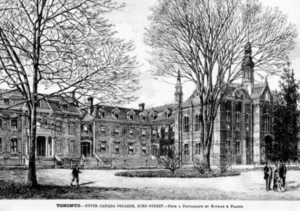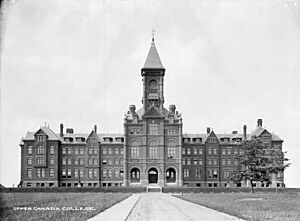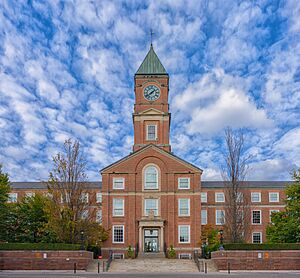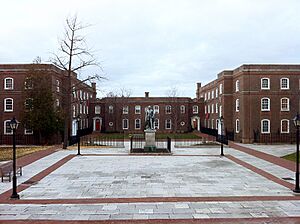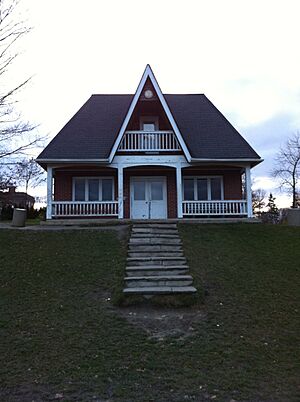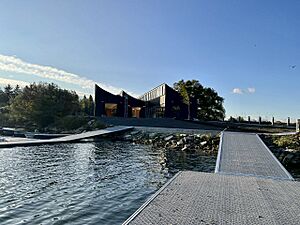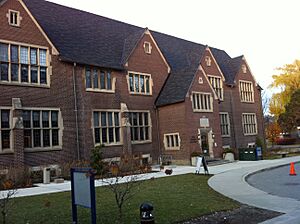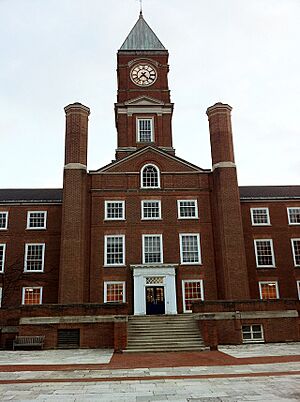Upper Canada College facts for kids
Quick facts for kids Upper Canada College |
|
|---|---|
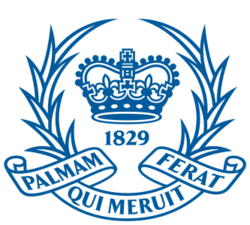 |
|
| Address | |
|
200 Lonsdale Road
, Ontario
Canada
|
|
| Information | |
| School type | Independent day and boarding |
| Motto | Palmam qui meruit ferat (Latin for 'Let he who merited the palm bear it') |
| Established | 1829 |
| Principal | Samuel James McKinney |
| Faculty | 140 |
| Grades | Kindergarten to grade 12 |
| Enrolment | 1,146 |
| • K – grade 7 | 416 |
| • Grades 8–12 | 730 |
| Campus | Deer Park/Forest Hill (38.5 acres [0.156 km2], urban) Norval (450 acres [1.8 km2], rural) |
| Colour(s) |
|
| Endowment | CA$107,000,000 |
| Visitor | Vacant |
Upper Canada College (UCC) is a private school for boys in Toronto, Ontario, Canada. It offers both day and boarding programs. The school uses the International Baccalaureate program, which is a special way of learning recognized around the world.
UCC is known as one of Canada's top schools for preparing students for university. Many famous people have graduated from UCC. With about 1,200 students, it is a very selective school, meaning it's hard to get in. UCC also helps Canadian students with financial aid, giving out over $5 million each year.
The high school part of UCC is split into 10 "houses." Eight of these houses are for day students, and two are for students who live at the school. The main building has a tall clock tower. The Toronto campus also has many sports fields, homes for staff, and other buildings. UCC also has a special outdoor education campus in Norval, Ontario.
UCC was started in 1829 by Sir John Colborne, who was then the Lieutenant Governor of Upper Canada. It was designed like Elizabeth College, Guernsey in the UK. After almost closing a few times, UCC became fully independent in 1900. This was nine years after it moved to its current location. It is the oldest independent school in Ontario and the third oldest in Canada. UCC keeps ties with the Canadian royal family. Members of the royal family or their representatives sometimes visit the college or serve on its Board of Governors.
Contents
History of UCC
How it Started and Grew
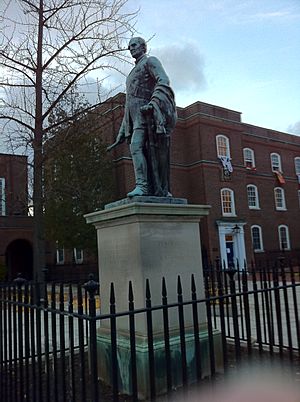
UCC was founded in 1829 by Sir John Colborne. He hoped it would prepare students for the new King's College (now the University of Toronto). UCC was inspired by famous British schools like Eton College. Even though it's now a private school, it started with public money and a large land grant.
The school first taught in the old Royal Grammar School. Within a year, it moved to its own campus at King and Simcoe streets. Sir John Colborne brought educated men from Cambridge and Oxford Universities in the UK to teach. He offered them good salaries.
Even with more students and visits from important people like the Earl of Elgin and praise from Charles Dickens, UCC faced challenges. Some people wanted to stop government funding and remove the college from its land.
The school joined with King's College for a while after 1831. Sixty years later, it moved to its current spot in Deer Park, which was a rural area then. In 1902, UCC added a separate building for younger students, called the Prep. This allowed boys to join from Grade Three all the way to graduation.
In 1900, the Ontario government stopped funding UCC, making it fully independent. By 1910, UCC had fewer students and less money. It thought about selling the Deer Park campus and moving to Norval, Ontario. But plans stopped when the First World War began. The college stayed where it was and grew, adding more buildings and attracting great teachers.
Principal William Grant helped the school develop even more. After he became principal in 1917, he hired teachers who were described as interesting and intelligent. Student numbers doubled, and financial help for students increased. Teacher salaries also doubled, and they received pension plans.
UCC had a Cadet Corps (a military training group) from around 1837. It helped defend against the Fenian Raids in 1866. This was one of only two times student groups were called to duty in Canadian military history. Historian Jack Granatstein noted that many UCC graduates became generals during the Second World War. A special display at the school honors UCC graduates who served in the military.
After the Second World War
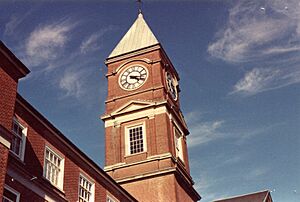
In 1958, UCC faced a big problem: the main building of the Upper School was in danger of falling down because it was not built well. At that time, UCC did not have much money saved up. An emergency fund was started, and with help from Prince Philip, $3.2 million was raised. Ted Rogers and his family paid for the clock tower. Robert Laidlaw gave money to build Laidlaw Hall. The current main building started being built in early 1959 and was opened by former governor general Vincent Massey in late 1960.
This problem made the school leaders think more about planning for the future. This led to new buildings, better salaries, and new ways to get money. Also, Vincent Massey helped bring new ideas to the school. Many important visitors came, and excellent teachers were hired. Around this time, the school's teaching changed from focusing on old classical studies to a broader liberal arts program. After 1950, students could choose languages other than Latin.
The years from 1965 to 1975 were a time of big changes at UCC. The school adapted to new ideas and trends happening in the world. The cadet corps was stopped in September 1975 and replaced with a smaller group of volunteers. The college kept its own high standards for education, even when new provincial standards were introduced. UCC also built new learning and sports facilities and opened its campus to the wider community. By the 1990s, summer camps were held on campus for any child who wanted to join.
The college started another building project in 1989, which finished in 1994. This included new sports facilities and a new building for the Prep school. Two years later, UCC started using the International Baccalaureate (IB) program, which added to the Ontario Secondary School Diploma. After this, Grade Two was added in 1998, and Grade One the next year. Since 2003, UCC has offered places from Senior Kindergarten to Grade Twelve.
Into the 21st Century
In 2002, the school's Board of Governors decided to start the Green School initiative. This meant that learning about the environment would become a key part of a UCC education. Plans included upgrading school buildings to be more environmentally friendly and adding these ideas to the lessons.
In 2004, Jim Power became principal. The school's teaching continued to change to help boys with learning and behavior. At the same time, UCC remained an all-boys school, even though other famous boys' schools in Ontario started accepting girls.
In 2007, the Board of Governors decided to close the boarding program, which had been around for 180 years. They thought fewer students wanted to live at school. However, students, alumni, and others disagreed strongly. So, the board changed its mind. They decided to keep boarding, but only if it had at least 60 students and the facilities were improved. The boarding houses were updated in 2013 and 2014.
Campus and Facilities
Toronto Campus
Upper Canada College has a large, open campus of about 17 hectares (43 acres) in Deer Park. It is close to Avenue Road and St. Clair Avenue. There are 15 buildings on the campus.
The main building, called the Upper School, was built between 1959 and 1960. It is in the center of the campus and has a tall clock tower. This building houses the high school part of the college. Laidlaw Hall, the main assembly hall with a stage and a pipe organ, is at one end. The Memorial Wing, the school's main health center, is at the other end. The main quadrangle (courtyard) has a statue of Lord Seaton. At the north end of the quadrangle is a building from 1932 that holds the two boarding houses and homes for the boarding masters. Next to this is the school chapel, given by Governor General Vincent Massey.
Around this main area are homes for teachers and their families. Grant House, built in 1917, is the principal's home. There is also a small, two-story cricket pavilion, opened by Governor General Ramon Hnatyshyn. The Preparatory School (Prep), for younger students, is at the southwest corner of the campus. Near it are a home for the Prep headmaster and a small gatehouse.
The sports facilities include an indoor pool and three gymnasiums. There is also the William P. Wilder sports complex, which has two hockey rinks (one NHL size and one Olympic size). Other facilities include a sports activity bubble, tennis courts, a running track, and nine sports fields. The two main fields for the Upper School are called Commons and Lords. One central field is known as the Oval. In 2006, the Oval and its running track were updated. The grass was partly replaced with a special turf, and the track was paved. Geothermal pipes were placed under the field to provide alternative energy heating for the Upper School and sports complex. Many of these facilities were built thanks to a $90 million fundraising effort in the 1990s.
The Ontario Heritage Trust has placed three plaques about UCC's history in Toronto. One is at 20 Duncan Street (an original campus building). The second is at 212 King Street West. The third is at the main entrance of the current campus at 200 Lonsdale Road.
Norval Campus
Upper Canada College also has an outdoor education center near Norval, Ontario. It is on 420 acres of land along the Credit River. This land was once used by First Nations people for camping and hunting.
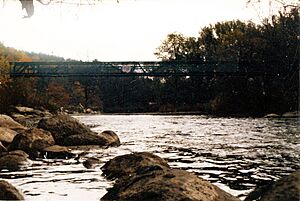
The main goal of Norval is to teach students about nature, sustainability, and ecosystems through outdoor learning. Some programs are run with Outward Bound Canada. Five full-time teachers and other staff work there. Throughout the school year, classes or groups of students stay at Norval for several days. Other Ontario schools also use the property when UCC students are not there. Norval hosts open houses each season, including "Maple Madness" in spring for maple syrup making, cross-country skiing in winter, and pumpkin carving in autumn.
The land was bought in 1913 when Toronto was growing quickly around the Deer Park campus. The college thought about moving the whole school there. But plans were stopped by the First World War and the Depression. The college tried to sell the land in 1928 and 1935 but found no buyers. Eventually, it became an outdoor education center. An annual picnic has been held at Norval since 1913. Over 700,000 seedlings were planted by staff and students in the 1940s to reforest the area. The first bunk house was built in the 1930s, and a larger building called Stephen House was added in 1967. Stephen House has classrooms, a lab, and living spaces for students and staff. Several log cabins were built in 2003 for writing retreats.
In 2007, UCC sold a small part of the Norval land. This helped cover costs related to a lawsuit the school faced. In 2011, a committee suggested that Norval's facilities should be expanded for more overnight students and for co-educational use.
Waterfront Facility
Upper Canada College has a waterfront site next to Lake Ontario at Toronto's Outer Harbour Marina. This is where the Don Lindsay Boathouse is located. The site is mainly used by UCC's rowing team for practice in the spring and fall. When the school's team is not using it, the facility becomes a community rowing center. It also hosts UCC's summer camps and the Horizons program.
Tuition, Scholarships, and Assets
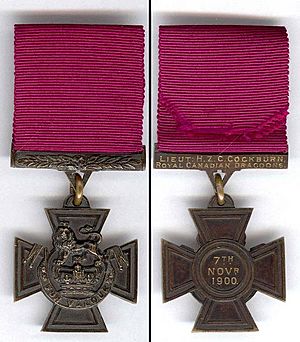
Upper Canada College is Canada's wealthiest independent school, with over CA$100 million in its savings fund. For the 2020–2021 school year, tuition fees for day students ranged from $34,135 to $37,135. For students who live at the school, fees ranged from $61,085 to $66,835. These fees do not include initial registration, books, or uniforms. The school says that less than two percent of Canadians can afford the full cost of attending. UCC has high admission standards, accepting about 20 percent of applicants in 2018–2019.
In 2012, the college started a fundraising campaign to get $100 million for scholarships. They received an $11 million donation from Stu Lang, which was the largest single gift ever to a Canadian independent school. To honor this gift, UCC created the Lang Scholar Program. This program recognizes up to 15 student-athletes each year who show great leadership potential. In 2019, UCC gave over $5.0 million in financial aid to about 20 percent of its students. Only students in grade five and above can get this help.
Besides its own historical records, UCC has a notable collection of art, antiques, and war medals. This includes the Order of Canada awards given to famous people like Robertson Davies and Foster Hewitt. It also has Canada's first Victoria Cross, awarded in 1854 to Alexander Roberts Dunn, and another Victoria Cross given to Hampden Cockburn. These medals were given to the Canadian War Museum on permanent loan in 2006.
The college's chapel has an altar made of marble from St. Paul's Cathedral in London, England, which was damaged during the war. On the altar is a cloth made from a piece used for the coronation of Queen Elizabeth II. The school also has an American flag that flew on one of the World Trade Center towers in New York City. UCC holds works by famous Canadian artists like the Group of Seven. It also has an original essay by Stephen Leacock and the original manuscript of Robertson Davies' work The Mask of Aesop. A chair once owned by Sir John A. Macdonald is also at the school.
Leadership and Staff
Upper Canada College is run by a 17-member Board of Governors. The current chair of the board is Russ Higgins. The board chooses the college's principal, who leads the school's daily operations. There are also many committees that help manage the school. The UCC Foundation, a charity, manages the school's savings.
There are 129 teachers at UCC. Many have advanced degrees, and 20 percent are International Baccalaureate examiners. 17 teachers live on campus. There are 18 students for every teacher in the lower grades and 19 students for every teacher in the upper grades.
Visitor

The "visitor" of Upper Canada College is a special role. This person has the right to inspect and report on the college.
Sir John Colborne was UCC's first informal visitor. The role was officially created in 1833. Over time, different important people held the role, including the lieutenant governor of Ontario.
In 1920, Prince Edward, Prince of Wales (who later became Edward VIII), became UCC's official visitor at his own request. He was removed from the role when he gave up the throne in 1936. The position was empty until 1955.
To keep a connection with the Canadian royal family, Prince Philip, Duke of Edinburgh (husband of Queen Elizabeth II) was appointed as visitor of UCC. He served in this role until his death in 2021, making him the longest-serving visitor in the college's history. He visited the college five times and helped with two fundraising campaigns. He also gave items to the school, including a signed cricket bat.
During his 1959 visit, Prince Philip was made an honorary Old Boy (a former student). He also revealed his personal coat of arms in the Massey Quadrangle. To celebrate the college's 150th anniversary, the Prince visited UCC for two days.
In May 2012, a student group at UCC suggested that another member of the royal family should become the next visitor. They hoped for someone young who could serve for many years, like Prince Philip had. Prince William, Duke of Cambridge (now the Prince of Wales) was the most popular choice.
Student Life
UCC is a non-religious school with about 1,000 day students and 88 boarders. Students from Senior Kindergarten to Grade Seven (about 400 boys) attend the Preparatory School (the Prep). After that, boys can move to the Upper School, which has Grades Eight to Twelve. The Upper School years are called:
- Grade Eight: Year Eight
- Grade Nine: Year Nine
- Grade Ten: Year Ten
- Grade Eleven: Year Eleven
- Grade Twelve: Year Twelve
While Prep students are in "forms," Upper School students are divided into "houses," like in some other schools. The house system started in 1923 with four houses and grew to the current ten. Eight houses are for day students: Bremner's, Howard's, Jackson's, Martland's, McHugh's, Mowbray's, Orr's, and Scadding's. The two boarding houses are Seaton's and Wedd's. The houses compete each year for the Prefects' Cup. Boarding students also have weekend activities and trips with students from nearby girls' schools.
Martland's house is named after John "Gentle" Martland, a teacher who improved the boarding houses. He made them more comfortable and organized fun activities. Wedd's is one of the oldest houses and is named after William Wedd, a former classical master.
The school's student government, called the Board of Stewards, was created in 1892. They represent students at events and share student ideas with the school leaders. This group has 19 elected members from the graduating class. Students can also join the "prefects" program. This means they show leadership in their senior years and receive the title of Prefect when they graduate. This is the highest honor UCC gives for good citizenship and leadership.
Upper Canada College has welcomed students from different backgrounds since its early days. The first black student enrolled in 1831, and First Nations boys also attended. The school has worked to become more diverse, reflecting Toronto's many cultures. Today, students from over 20 different countries attend UCC. The decision to keep the boarding program was partly to allow students from around the world to attend. The school also expanded financial aid in 2012 to help students from different economic backgrounds.
Learning at UCC
Upper Canada College teaches boys from Senior Kindergarten to Grade Twelve. Graduates receive both the Ontario Secondary School Diploma and the International Baccalaureate (IB) diploma. UCC started the IB program in 1996, and it guides the entire curriculum today.
In the Prep School, boys learn French, language, mathematics, science, outdoor education, physical education, and the arts. When boys move to the Upper School in Year One (Grade Eight), they begin preparing for university through a liberal arts program. Their courses include mathematics, history, geography, science, English, second languages, civics, design, film, and the dramatic, visual, and musical arts, as well as computer science.
The Wernham West Centre for Learning helps both students and teachers. It is Canada's most complete learning facility for a high school. Started in 2002, it helps students improve their academic skills and supports those with learning differences.
Activities and Clubs
UCC encourages students to join extracurricular activities. All students must complete 40 hours of community service to get their Ontario Secondary School Diploma. They also need to complete 150 hours of other activities, split equally between arts, athletics, and community service (called CAS in the IB program).
Arts and Sports
Upper Canada College has many theater programs, from musicals to Shakespeare plays. There is at least one large and one small play each year. Smaller plays are also written and performed by students. The theater program works with Bishop Strachan School, a nearby girls' private school.
Various bands and music groups also practice after school, including a wind ensemble, stage band, string ensemble, jazz ensemble, and singers. These groups perform at festivals and organize concerts to raise money. UCC has sports rivalries with other boys' schools in Ontario.
UCC has teams for alpine ski, baseball, basketball, cricket, football, golf, hockey, rowing, rugby, lacrosse, soccer, squash, swimming, Track and Field, tennis, and volleyball. Some teams are just for fun within the school, but 45 teams compete against other schools. They often do well in national and international competitions.
Special Programs
The World Affairs Conference is Canada's oldest student-run conference. It started in 1983 and has worked with Branksome Hall since the late 1980s. Held every year, the conference has hosted over 4,000 students from 25 countries and 65 schools. Past speakers have included Mehdi Hasan, Ralph Nader, Stephen Lewis, and Edward Snowden. They have spoken on topics like human rights, gender issues, and justice. The conference has received support letters from the Mayor of Toronto and the Prime Minister of Canada.
UCC students also lead the OMUN, a Model UN conference. It hosts around 400–500 students each year, including international groups. UCC has 50–100 clubs, with Model UN and DECA being very popular.

The UCC Green School is an environmental group of students and teachers. Through this group, UCC has planted and cared for an organic garden. They have also reduced waste and water use and buy renewable resources for renovations. The Green School has won awards from the City of Toronto and the National Audubon Society.
School Media
The college has its own publishing company, the UCC Press. It produces all school publications. It used to print books and histories, but now it mainly prints school-related materials like newspapers, alumni magazines, and financial reports.
The College Times is UCC's yearbook. It is the oldest school publication in Canada, published every year since 1857. Famous past editors include Robertson Davies and Stephen Leacock. Upper Canada College also has an online publication, The Blue and White (TBAW, tbaw.ca). Students write articles about school life and current events for it. Old Times is the school's magazine for former students, sharing news about their lives and upcoming events.
Other student publications include The Blazer (a humor newspaper), Quiddity (an arts and literature publication), and The Blue Page (a weekly page for letters to the editor). Convergence is the school's award-winning student newspaper. BluesTV was a student-led school television network that started in 2007.
Community Service
Upper Canada College encourages students to volunteer and help their community. The college runs the Horizons program, where UCC students tutor local children in music, digital media, and school subjects twice a week. Each year, usually during Spring Break, UCC also organizes trips for 15 to 20 Upper School students to different countries. They help build schools, wells, and homes, or work on conservation projects. Students have traveled to places like Venezuela, El Salvador, Kenya, and China.
Events
Every year, the school plans many events. Some are only for students in certain grades, while others are for all students, alumni, and their families. These events help build school spirit, provide fun, and raise money for good causes. Many are organized by the Upper Canada College Association with help from parents and student volunteers.
Association Day, also known as A-Day, is like UCC's homecoming. It has been held since 1979 and is the school's biggest annual event. It takes place on the last weekend of September. The main day is Saturday, with a big festival, sports games, and a dinner for alumni. Later in the school year is the Founder's Dinner, a formal event held for over a century. It usually happens in January to celebrate Sir John Colborne's birthday. Another regular event is the UCC Gala, a fancy dinner and silent auction held every three or four years in May.

Two dances for high school students happen each year. The Battalion Ball started from an event called At Home in 1887. By 1897, a dance was added, and it became known as the Rifle Corps Dance. In 1931, it was renamed the Battalion Ball. Today, the Batt Ball is for students in grades 11 and 12. It is held at places like the Royal York Hotel. Boys wear tuxedos, and girls wear evening gowns or cocktail dresses. Music is provided by DJs. The Stewards' Dance is UCC's fall semi-formal dance. It often has costume party themes and is for students in grades 11 and above.
Various sports events happen annually. Hockey Night has been held since 1933. The First Hockey team plays a special game against a rival school for the Foster Hewitt Victory Trophy. The game used to be held at Maple Leaf Gardens and later at other large arenas. Other games have been added, including games for younger teams. The Terry Fox Run is one of UCC's most successful events. The school is an official starting and ending point for the run, which goes through Toronto's Belt-Line. UCC's Terry Fox Run is the largest site and has raised the most money in the world since 2000. The Prep Games Day is an annual event at the junior school.
Connections
Upper Canada College is a member of several important school groups. These include the Conference of Independent Schools of Ontario (CIS), the Canadian Accredited Independent Schools (CAIS), and the G30 Schools. The college principal is also a member of the Headmasters' and Headmistresses' Conference (HMC) in the UK. Along with St. Andrew's College, Ridley College, and Trinity College School, UCC is part of the Little Big Four, an athletic group of Ontario independent boys' schools started in the 1800s.
Bishop Strachan School (BSS) is only two blocks from UCC and is UCC's sister school. UCC students work on projects with students from other nearby girls' schools, including BSS, St. Clement's School, Havergal College, and Branksome Hall.
People of UCC
Alumni

The college says that almost every UCC graduate, known as an Old Boy, goes on to university or college. There are over 6,000 Old Boys around the world. Many famous and important people have graduated from UCC.
The school has produced 26 Rhodes Scholars and five Loran Scholars. Six graduates became lieutenant governors, four were appointed as premiers, seven as chief justices, and four were elected as Mayor of Toronto. Many Old Boys have received high honors like the Order of Canada and the Order of Ontario. Ten are Olympic medallists, and eight have played in the National Hockey League.
Faculty

Some notable teachers at Upper Canada College have included:
- Robertson Davies – a famous author
- Mike Eben – a football star and radio/TV narrator
- David Gilmour – an author and broadcast journalist
- Stephen Leacock – a world-famous humorist
- Bruce Littlejohn – a photographer, writer, and conservationist
- John McCaul – the second President of UofT
- Sir George Robert Parkin – a leader in the Imperial Federation League
- Sir Edward Robert Peacock – a director of the Bank of England
- Henry Scadding – a Canadian intellectual
- Goldwyn Smith - a British historian and professor
- Arthur Sweatman – an Archbishop of Toronto
UCC Association
The Upper Canada College Old Boys' Association was started in 1891. In 1969, its name changed to the Upper Canada College Association. This group now includes parents, teachers, staff, and friends of the college. They help with school matters like leadership and fundraising. The association also runs programs, like allowing recent graduates to mentor students. Alumni reunions are organized around the world by the association's branches in different cities and countries.
A board of 29 directors, called the Association Council, meets three times a year. They discuss school matters and plan events. Four of the 17 members of the college's Board of Governors come from the association board.
School Symbols
Upper Canada College's motto is palmam qui meruit ferat (Latin for 'let he who merited the palm bear it'). This phrase comes from a poem by John Jortin. It was first used with UCC in 1833 on prize books. The words were on a ribbon around the school's name, with laurel leaves. Around 1850, a crown replaced the school's name. The crown used was that of King George IV.
In 1889, Henry Scadding designed an emblem that can still be seen over the doors to Laidlaw Hall. This design included symbols from Lord Nelson's coat of arms, an open book for education, and a part of the standard of St. George to show the school's connection to England. It also included a crown and a symbol for the full school life at UCC. This complex design was not widely used. Instead, a simpler emblem with a crown between laurel leaves and the motto became the standard.
In the mid-1970s, the college decided to have its emblem officially approved. The Board of Governors wanted to keep the traditional emblem, which included a royal crown. To use the royal crown officially, they needed the Canadian monarch's personal permission. Queen Elizabeth II agreed to the request. This made UCC the only school of its kind in the Commonwealth to have the royal crown in its arms.
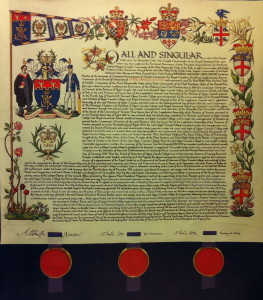
The official documents granting UCC its symbols, including a heraldic standard, were issued on January 4, 1985. This was the 155th anniversary of the college's first day of classes. The traditional emblem became the school's official badge. The motto was left out of the badge, but the date 1829 was allowed to stay. The emblem also became the crest of the school's new arms, but without the 1829 date.
The main shield of the arms shows two deer's heads. One is from the founder, Lord Seaton, and the other from Bishop John Strachan, the first chairman of the board. Below this is Scadding's Device with another royal crown. The shield is held up by a teacher in a gown and a student in a cricket uniform, both dressed in mid-19th century style. These symbols were officially registered in 2005.
Images for kids
See also
- Education in Ontario
- List of Canadian organizations with royal patronage
- Lower Canada College


